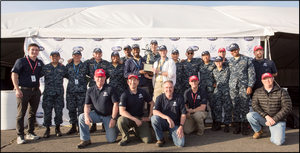DronesService Academies Swarm Challenge: Expanding the capabilities UAV swarms
More than forty Cadets and Midshipmen from the U.S. Military Academy, the U.S. Naval Academy, and the U.S. Air Force Academy helped expand the capabilities of swarms of highly autonomous unmanned aerial vehicles (UAVs) last month in the Service Academies Swarm Challenge. In the skies over Camp Roberts, an Army National Guard post north of Paso Robles, Calif., each academy demonstrated the innovative offensive and defensive tactics they had developed over the school year. The three-day experiment concluded with an exciting aerial battle in which the Naval Academy took home the win, a trophy, and bragging rights over its rival academies.

Answering the call to develop swarm tactics // Source: darpa.mil
They came, they flew, they wildly exceeded expectations.
More than forty Cadets and Midshipmen from the U.S. Military Academy, the U.S. Naval Academy, and the U.S. Air Force Academy helped expand the capabilities of swarms of highly autonomous unmanned aerial vehicles (UAVs) last month in the Service Academies Swarm Challenge. In the skies over Camp Roberts, an Army National Guard post north of Paso Robles, Calif., each academy demonstrated the innovative offensive and defensive tactics they had developed over the school year. The three-day experiment concluded with an exciting aerial battle in which the Naval Academy took home the win, a trophy, and bragging rights over its rival academies.
“The teams absolutely achieved their goal for this event by demonstrating 25-on-25 mixed swarms of fixed-wing and quad-rotor aircraft conducting swarm-on-swarm battles,” said Timothy Chung, the DARPA program manager leading the research effort. “The Cadets and Midshipmen developed innovative tactics for these highly autonomous swarms and demonstrated those tactics in live-fly experiments. It was a phenomenal success.”
DARPA says that that success was the result of the teams and DARPA alike overcoming numerous obstacles in the eight months leading to the final Live-Fly Competition. In addition to creating viable tactics, the students had to manage their own packed schedules, diverse areas of study, and the complex technology, logistics, and team assignments for the competition itself. In this short period of time, DARPA developed, built, and tested custom communications networks and various real-time data-visualization systems designed to track dozens of UAVs simultaneously.
How it all would work out was a big question as the teams gathered and readied their systems. Before the Live-Fly Competition, no team had fielded more than four aircraft at the same time. The first day, the competing teams raised that number to 20 aircraft on a side, in heterogeneous groups of fixed-wing UAVs and quad-rotors. Two short days later, the championship match had 60 aircraft flying—25 on 25 competing, with five additional aloft per team circling in reserve, again in mixed groups.
“One of the most exciting outcomes of it,” Chung said, “has been the opening of the eyes and the imagination—not only of the Cadets and Midshipmen, not only of the researchers that helped create this technology, but also of the attending warfighters and operators who were able to watch the Cadets and Midshipmen engage in swarm-versus-swarm battle in live flight and understand both what swarms are able to do
